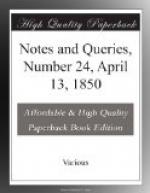Symbols of the Four Evangelists.—St. Matthew an angel; St. Mark, a lion; St. Luke, an ox; St. John, an eagle. It is on account of its being a symbol of the Resurrection that the lion is assigned to St. Mark as an emblem; St. Mark being called the historian of the Resurrection. (This title he probably obtained from his gospel being used on Easter Day.) The reason why the lion is taken as a symbol of the Resurrection is to be found in the fabulous history of the animal; according to which the whelp is born dead, and only receives life at the expiration of three days, on being breathed on by its father.—What are the reasons assigned for the other three Evangelists’ emblems?
Jarlzberg.
Portrait by Boonen.—Can any of your correspondents state the precise time when Boonen, said to be a pupil of Schalcken, flourished? And what eminent geographer, Dutch or English, lived during such period? This question is asked with reference to a picture by Boonen,—a portrait of a singular visaged man, with his hand on a globe, now at Mr. Peel’s in Golden Square; the subject of which is desired to be ascertained. It may be the portrait of an astrologer, if the globe is celestial.
Z.
Beaver Hats.—On the subject of beaver hats, I would ask what was the price or value of a beaver hat in the time of Charles II.? I find that Giles Davis of London, merchant, offered Timothy Wade, Esq., “five pounds to buy a beaver hat,” that he might he permitted to surrender a lease of a piece of ground in Aldermanbury. (Vide Judicial Decree, Fire of London, dated 13. Dec. 1668. Add. MS. 5085. No. 22.)
F.E.
* * * * *
REPLIES.
BLUNDER IN MALONE’S SHAKSPEARE.
I regret that no further notice has been taken of the very curious matter suggested by “Mr. Jebb” (No 14. p. 213.), one of the many forgeries of which Shakspeare has been the object, which ought to be cleared up, but which I have neither leisure nor materials to attempt; but I can afford a hint or two for other inquirers.
1. This strange intermixture of some John Shakspeare’s confession of the Romish faith with William Shakspeare’s will, is, as Mr. Jebb states to be found in the Dublin edition of Malone’s Shakspeare, 1794, v. i. p. 154. It is generally supposed that this Dublin edition is a copy (I believe a piracy) of the London one of 1790; but by what means the three introductory paragraphs of John Shakspeare’s popish confession were foisted into the real will of William is a complete mystery.




